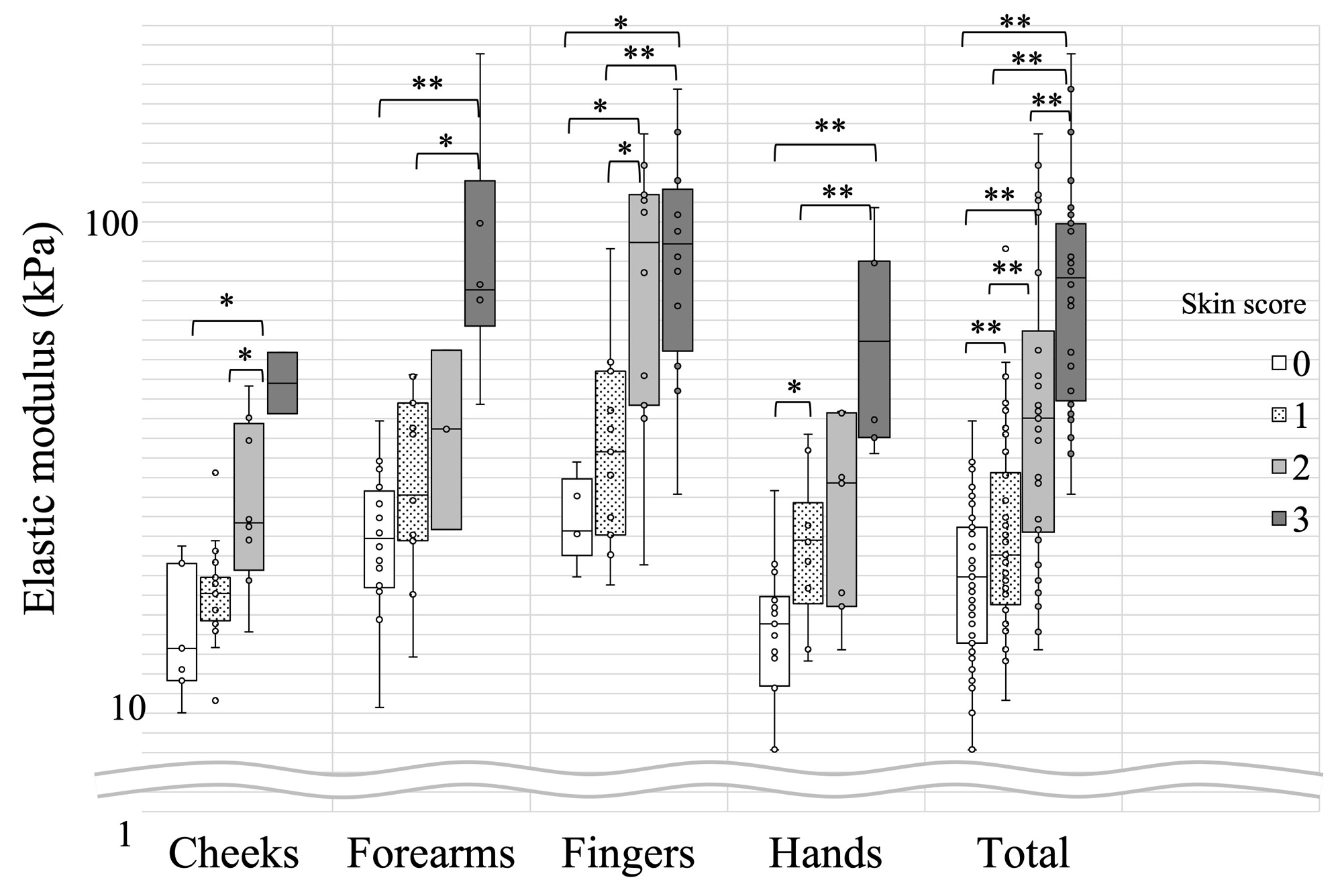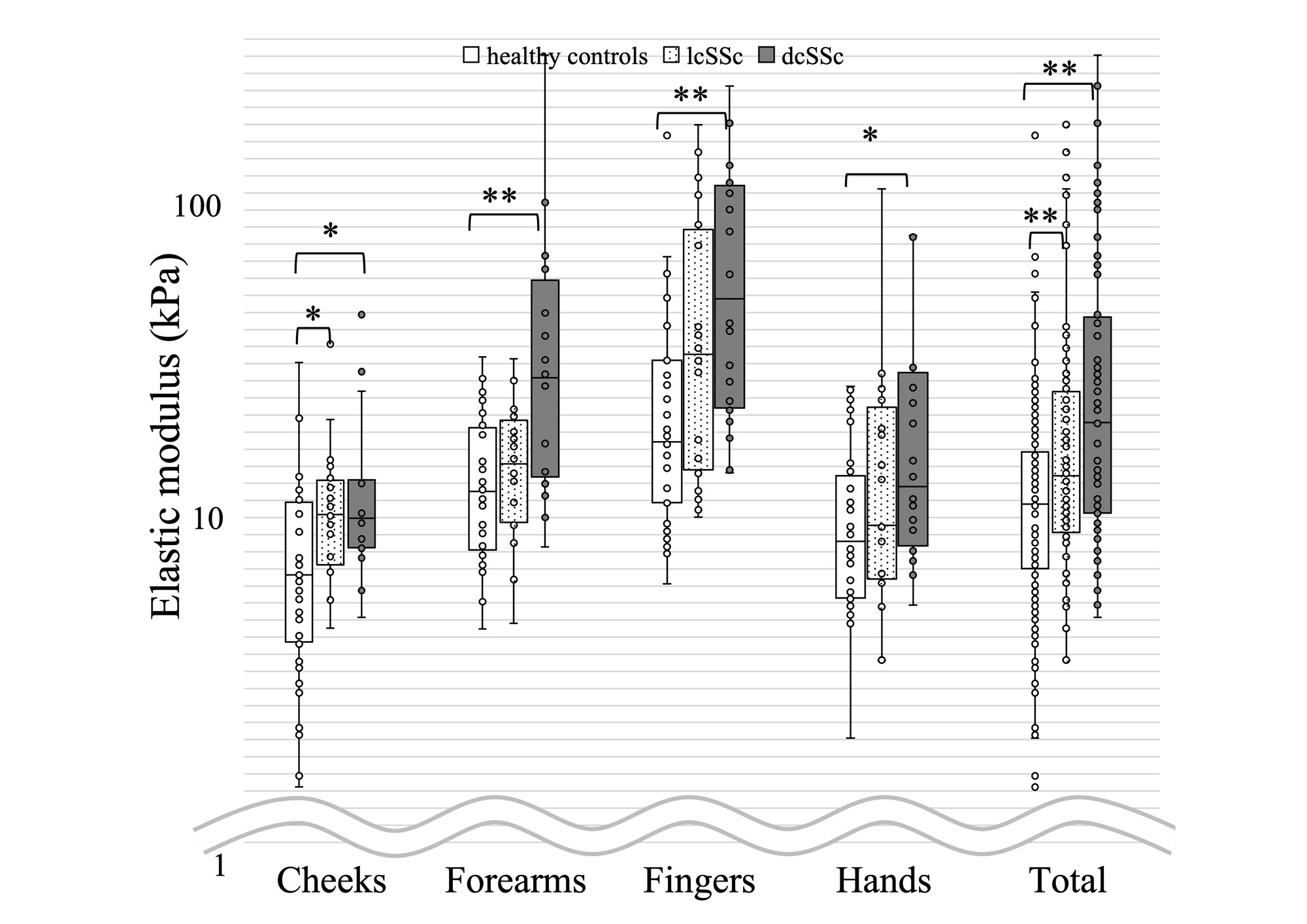Session Information
Date: Sunday, November 12, 2023
Title: (0609–0672) Systemic Sclerosis & Related Disorders – Clinical Poster I: Research
Session Type: Poster Session A
Session Time: 9:00AM-11:00AM
Background/Purpose: No quantitative and objective methods for measuring skin hardness have been established. Japanese technology leads the world in the tactile sensor field, and SOFTGRAM has received an award from the Going-Global Innovations Competition 2019.This study aimed to verify whether SOFTGRAM, a device that can measure elastic modulus using the Hertz elastic contact theory, could be used to evaluate skin hardness in systemic sclerosis (SSc). As a far-reaching effect, this study might be one of the triggers to progress a diagnosis with medical artificial intelligence systems for various diseases.
Methods: Skin score according to the modified Rodnan’s total skin thickness score and elastic modulus of the skin using SOFTGRAM were measured for 20 patients with SSc and 20 healthy controls on 8 parts, both of the cheeks, forearms, fingers, and hands (Figure 1). Five observers shared to measure skin score 320 times (40 participants × 8 parts). Elastic modulus was measured 1600 times (40 participants × 8 parts × 5 times each). As an additional examination to compare differences among observers, the skin score of another healthy control was measured 40 times (5 observers × 8 parts). Elastic modulus was measured 200 times (5 observers × 8 parts × 5 times each).
Results: Data were collected from 20 healthy Japanese controls (1 male and 19 females; 63.2±12.3 years old), 10 lcSSc patients (10 females; 65.9±6.3 years old), and 10 dcSSc patients (1 male and 9 females; 58.8±14.9 years old).Our findings reveal a significant correlation between elastic modulus and skin score (correlation coefficient=0.67, p< 0.001; Figure 2). Furthermore, we observed significant differences in elastic modulus among healthy controls, limited cutaneous SSc, and diffuse cutaneous SSc (22.6±15.7 vs. 32.0±27.7 vs. 44.8±39.8, p< 0.001; Figure 3). Intraobserver reliabilities were sufficient in 6 of 7 observers; however, interobserver was less satisfactory.It would be because elastic modulus depended on the skin position and the power and speed to push by SOFTGRAM. Regarding the skin position, bone hyperreflection might affect elastic modulus. If SOFTGRAM is improved to measure only the more shallow parts, the effect of bone hyperreflection might be minimal.
Conclusion: SOFTGRAM has many advantages compared to previous methods. This study showed the practicality of SOFTGRAM as an accurate measurement method of skin hardness but also revealed points to be improved. SOFTGRAM will have further improvements, and sensing devices will be able to useful especially for clinical trials and research.
To cite this abstract in AMA style:
Kokubu H, Ikuno Y, Uchiyama K, Kato M, Yamamoto M, Asada H, Rikitake S, Kobayashi Y, Koike T, Sugiura S, Hayami T, Yoneta K, Takahashi T, Yamamoto B, Kato T, Kunisaki Y, Nakatani M, Okamoto K, Fujimoto N. Quantification of Skin Hardness of Patients with Systemic Sclerosis Using SOFTGRAM [abstract]. Arthritis Rheumatol. 2023; 75 (suppl 9). https://acrabstracts.org/abstract/quantification-of-skin-hardness-of-patients-with-systemic-sclerosis-using-softgram/. Accessed .« Back to ACR Convergence 2023
ACR Meeting Abstracts - https://acrabstracts.org/abstract/quantification-of-skin-hardness-of-patients-with-systemic-sclerosis-using-softgram/



